Abstract
The temporal dynamics of electrical activity in an olfactory organ, the procerebral lobe of the terrestrial mollusc Limax maximus, is studied. The lobe exhibits intrinsic oscillations in its field potential. Intracellular recordings show that the lobe contains two classes of neurons, both with activity phase-locked to the oscillation. Neurons in one class produce periodic bursts of spikes while those in the other class fire infrequently but receive strong, periodic inhibition whose onset coincides with the burst. The large-scale activity of these neurons is imaged in preparations stained with voltage-sensitive dyes. We observe waves of electrical activity that span the width of the lobe and travel its full length along a longitudinal axis. Simultaneous optical and intracellular recordings show that the form of the wave reflects the electrical activity of both classes of neurons. The application of natural odor stimuli causes the electrical activity along the lobe to transiently switch from the state with propagating waves to one with spatially uniform oscillations. The behavioral and computational relevance of this change in global timing is discussed.
Full text
PDF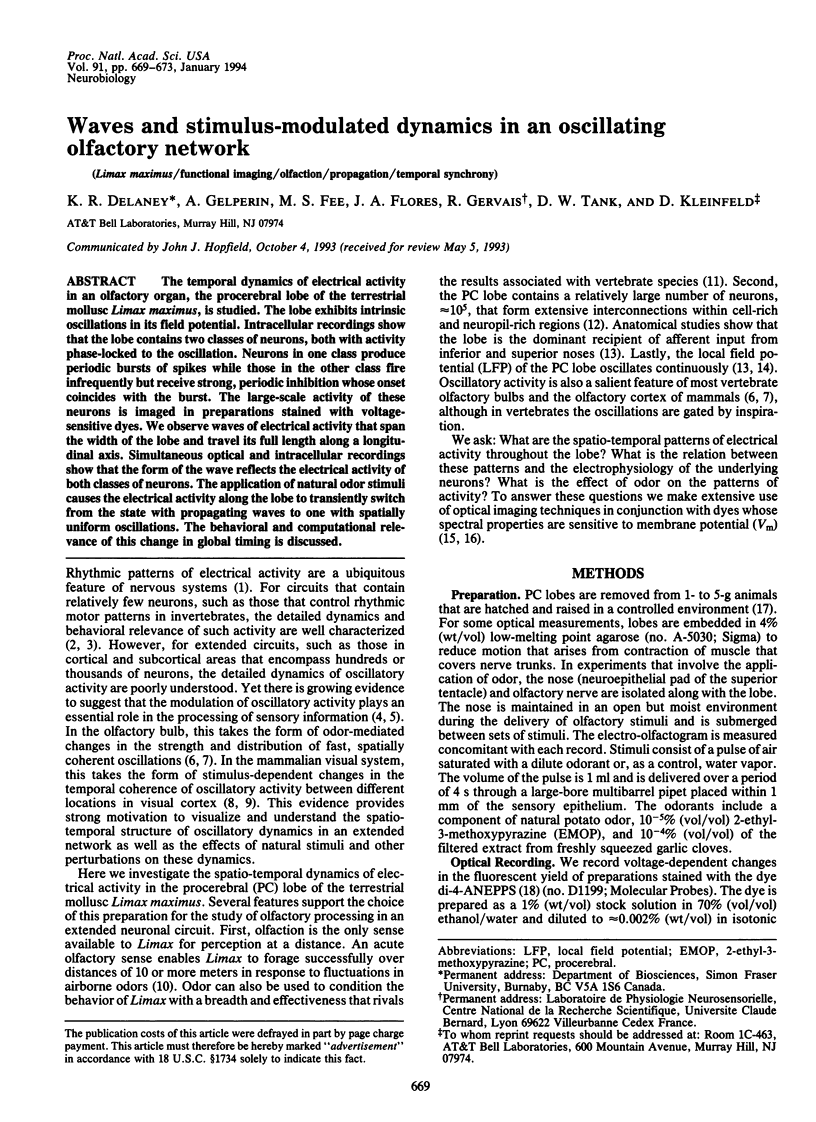
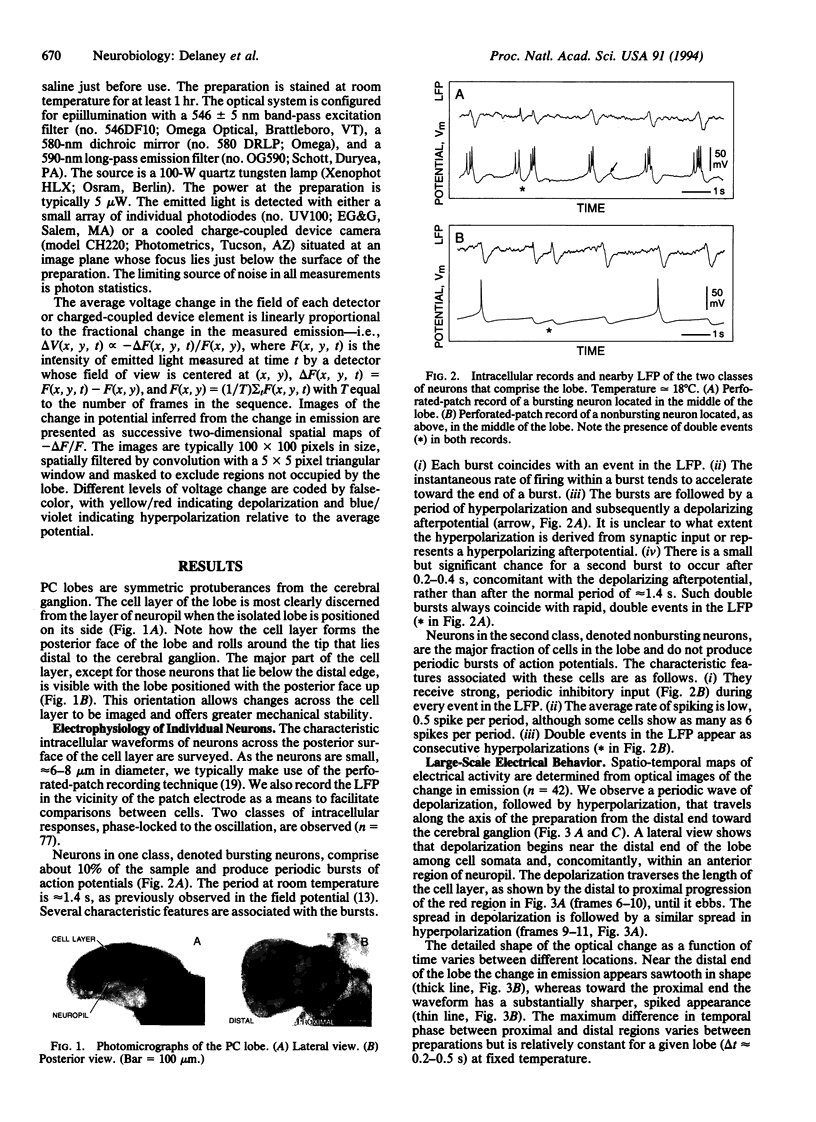
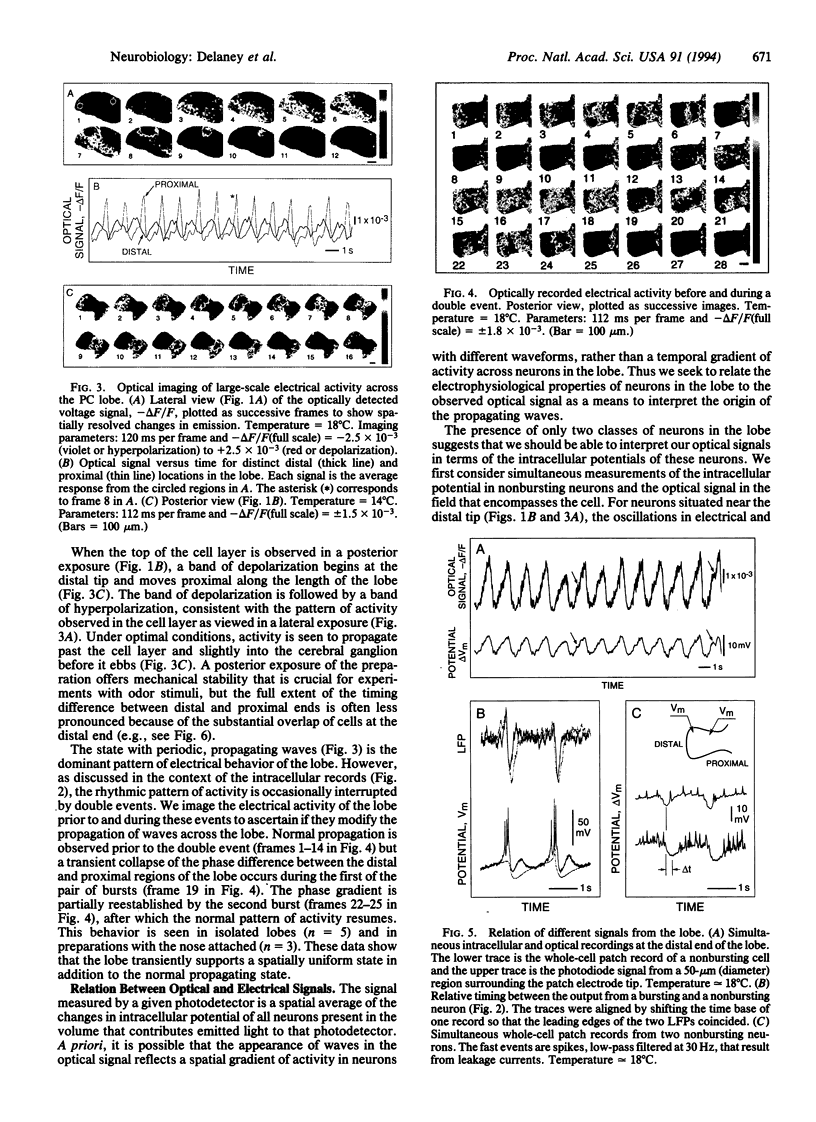
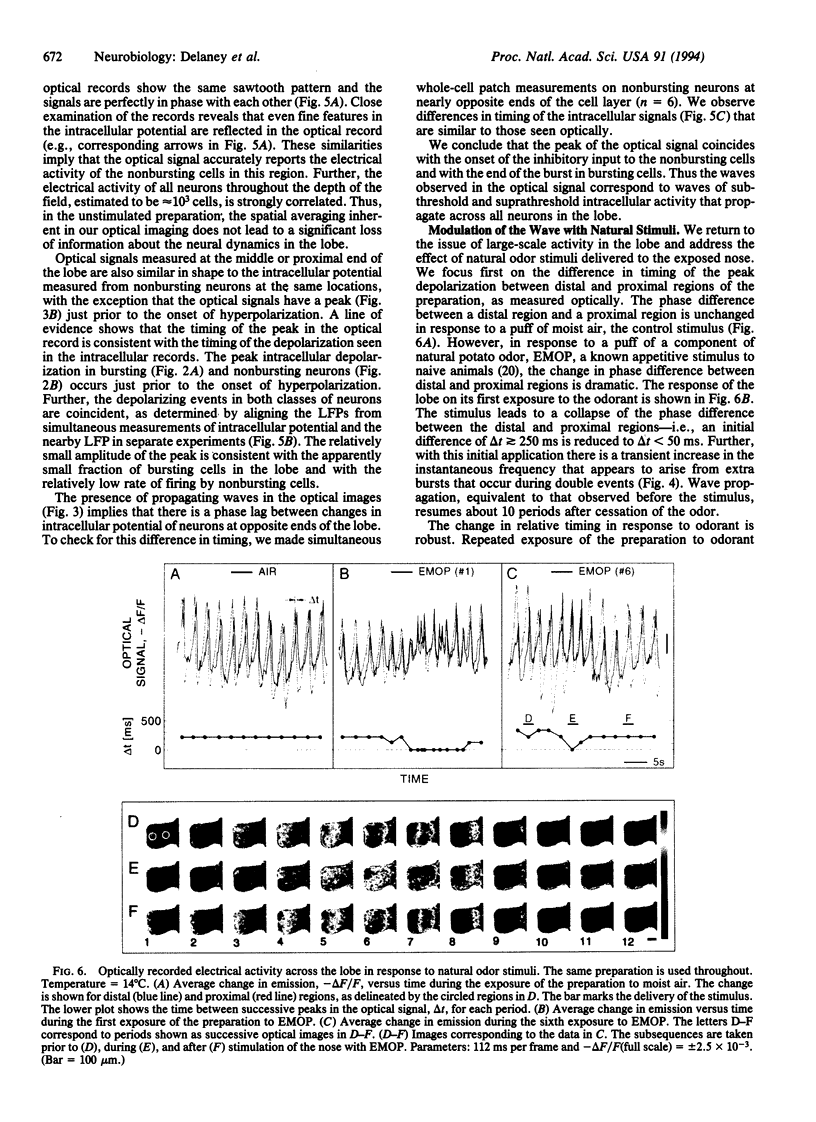
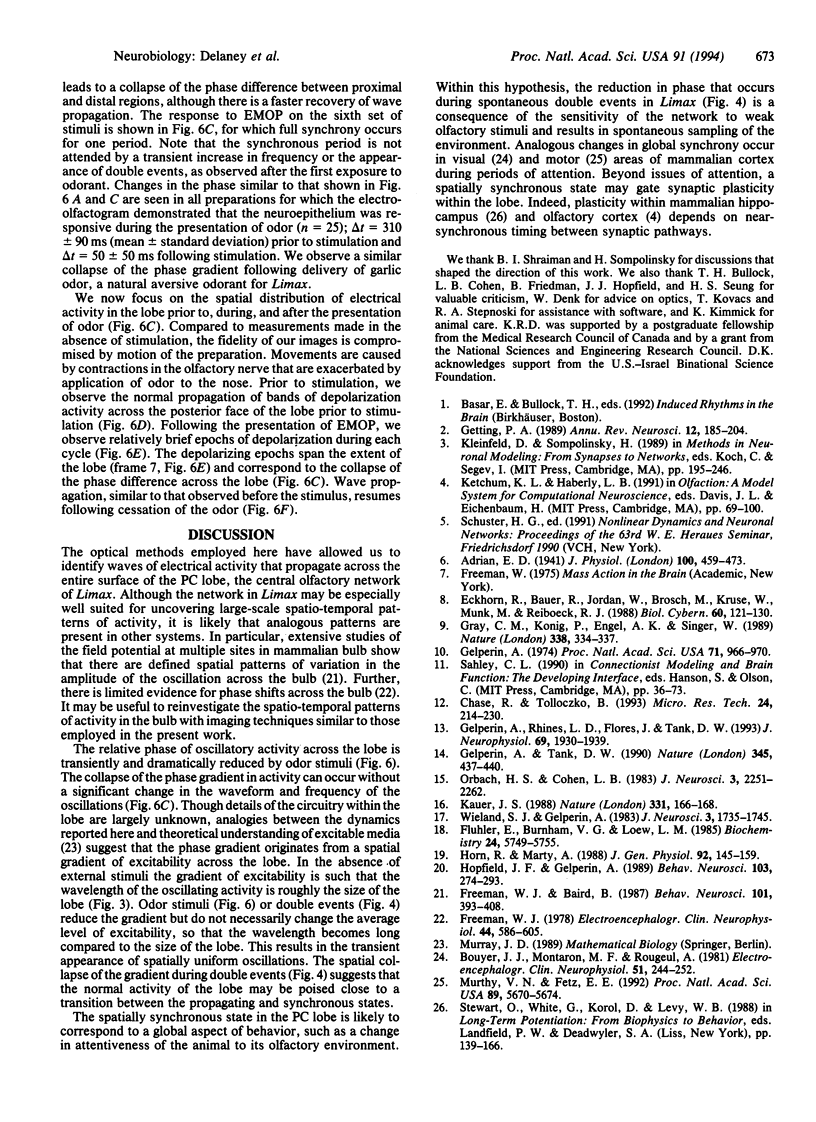
Images in this article
Selected References
These references are in PubMed. This may not be the complete list of references from this article.
- Adrian E. D. Olfactory reactions in the brain of the hedgehog. J Physiol. 1942 Mar 31;100(4):459–473. doi: 10.1113/jphysiol.1942.sp003955. [DOI] [PMC free article] [PubMed] [Google Scholar]
- Bouyer J. J., Montaron M. F., Rougeul A. Fast fronto-parietal rhythms during combined focused attentive behaviour and immobility in cat: cortical and thalamic localizations. Electroencephalogr Clin Neurophysiol. 1981 Mar;51(3):244–252. doi: 10.1016/0013-4694(81)90138-3. [DOI] [PubMed] [Google Scholar]
- Chase R., Tolloczko B. Tracing neural pathways in snail olfaction: from the tip of the tentacles to the brain and beyond. Microsc Res Tech. 1993 Feb 15;24(3):214–230. doi: 10.1002/jemt.1070240303. [DOI] [PubMed] [Google Scholar]
- Eckhorn R., Bauer R., Jordan W., Brosch M., Kruse W., Munk M., Reitboeck H. J. Coherent oscillations: a mechanism of feature linking in the visual cortex? Multiple electrode and correlation analyses in the cat. Biol Cybern. 1988;60(2):121–130. doi: 10.1007/BF00202899. [DOI] [PubMed] [Google Scholar]
- Fluhler E., Burnham V. G., Loew L. M. Spectra, membrane binding, and potentiometric responses of new charge shift probes. Biochemistry. 1985 Oct 8;24(21):5749–5755. doi: 10.1021/bi00342a010. [DOI] [PubMed] [Google Scholar]
- Freeman W. J., Baird B. Relation of olfactory EEG to behavior: spatial analysis. Behav Neurosci. 1987 Jun;101(3):393–408. doi: 10.1037//0735-7044.101.3.393. [DOI] [PubMed] [Google Scholar]
- Freeman W. J. Spatial properties of an EEG event in the olfactory bulb and cortex. Electroencephalogr Clin Neurophysiol. 1978 May;44(5):586–605. doi: 10.1016/0013-4694(78)90126-8. [DOI] [PubMed] [Google Scholar]
- Gelperin A. Olfactory Basis of Homing Behavior in the Giant Garden Slug, Limax maximus. Proc Natl Acad Sci U S A. 1974 Mar;71(3):966–970. doi: 10.1073/pnas.71.3.966. [DOI] [PMC free article] [PubMed] [Google Scholar]
- Gelperin A., Rhines L. D., Flores J., Tank D. W. Coherent network oscillations by olfactory interneurons: modulation by endogenous amines. J Neurophysiol. 1993 Jun;69(6):1930–1939. doi: 10.1152/jn.1993.69.6.1930. [DOI] [PubMed] [Google Scholar]
- Gelperin A., Tank D. W. Odour-modulated collective network oscillations of olfactory interneurons in a terrestrial mollusc. Nature. 1990 May 31;345(6274):437–440. doi: 10.1038/345437a0. [DOI] [PubMed] [Google Scholar]
- Getting P. A. Emerging principles governing the operation of neural networks. Annu Rev Neurosci. 1989;12:185–204. doi: 10.1146/annurev.ne.12.030189.001153. [DOI] [PubMed] [Google Scholar]
- Gray C. M., König P., Engel A. K., Singer W. Oscillatory responses in cat visual cortex exhibit inter-columnar synchronization which reflects global stimulus properties. Nature. 1989 Mar 23;338(6213):334–337. doi: 10.1038/338334a0. [DOI] [PubMed] [Google Scholar]
- Horn R., Marty A. Muscarinic activation of ionic currents measured by a new whole-cell recording method. J Gen Physiol. 1988 Aug;92(2):145–159. doi: 10.1085/jgp.92.2.145. [DOI] [PMC free article] [PubMed] [Google Scholar]
- Kauer J. S. Real-time imaging of evoked activity in local circuits of the salamander olfactory bulb. Nature. 1988 Jan 14;331(6152):166–168. doi: 10.1038/331166a0. [DOI] [PubMed] [Google Scholar]
- Murthy V. N., Fetz E. E. Coherent 25- to 35-Hz oscillations in the sensorimotor cortex of awake behaving monkeys. Proc Natl Acad Sci U S A. 1992 Jun 15;89(12):5670–5674. doi: 10.1073/pnas.89.12.5670. [DOI] [PMC free article] [PubMed] [Google Scholar]
- Orbach H. S., Cohen L. B. Optical monitoring of activity from many areas of the in vitro and in vivo salamander olfactory bulb: a new method for studying functional organization in the vertebrate central nervous system. J Neurosci. 1983 Nov;3(11):2251–2262. doi: 10.1523/JNEUROSCI.03-11-02251.1983. [DOI] [PMC free article] [PubMed] [Google Scholar]
- Wieland S. J., Gelperin A. Dopamine elicits feeding motor program in Limax maximus. J Neurosci. 1983 Sep;3(9):1735–1745. doi: 10.1523/JNEUROSCI.03-09-01735.1983. [DOI] [PMC free article] [PubMed] [Google Scholar]






